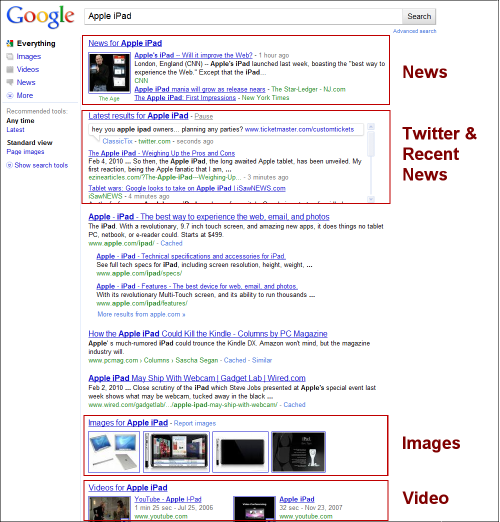
Don’t ignore digital assets in your optimization efforts
Don’t fight it: Blended search results, and hence digital asset optimization, are here (at least for now).
Text content may be your SEO poster child, but with images, video and audio content often appearing in standard search results, digital assets can no longer be treated as the ugly stepsister in the online marketing family. Many companies produce a variety of content and media that never make it to the public web.
To this point, the majority of marketers have either overlooked or ignored optimization of non-text digital assets. In fact, a recent Forrester study found:
- Less than 20% of marketers insert keywords into the filenames of videos on their sites
- Even fewer marketers write keyword-rich captions or create online video libraries
- Yet video stands about a 50% greater chance of ranking on page one of Google
If digital asset optimization isn’t on your radar at all or simply stuck on your back burner, it’s time to rethink your strategy.
Show your digital assets a little respect with these 5 optimization tips.
1. Do your homework on the SERPs
Be sure to become familiar with the types of files and media types that Google and other search engines are prone to display for the keyword phrases you’re targeting. Certain types of queries are more prone to show local, shopping or news results and if you can identify frequently used data sources, your time figuring out what digital assets to optimize can be a lot more efficient.
In the example below, a search for “Apple iPad” shows search results from News, Twitter, Images and Video. Here, news sources range from mainstream media like CNN to ezinearticles. A savvy SEO would consider how they might leverage exposure in the news area, via social media such as blogs or Twitter as well as videos and images. Producing, optimizing and promoting relevant video and images provides an additional opportunity for visibility in addition to web pages.

The display of blended results, especially where current news is involved, is dynamic. Be sure to revisit the search results page from time to time to uncover any new data sources for assets/media you may be able to focus on.
2. Repurpose content to get the most bang for your buck
Think of innovative ways to reuse your digital assets to gain maximum search benefits. For example, if your CEO gives a presentation at an industry event:
- The presentation can often be recorded on video and audio
- The video can be optimized and promoted on both your website and numerous video hosting sites such as You Tube
- Multiple short video snippets can be created from one master video, all of which can be optimized
- A search-optimized podcast can be created from the audio, which can be placed on your website and promoted on podcast web aggregation sites
- Screenshots can be taken from the video, optimized, placed on your website and promoted on sites like Flickr (check out these tools for optimizing images from Six Revisions blog)
- The optimized images, podcast and video can all be used with social media press releases for even more exposure
- The PowerPoint from the presentation could be uploaded to Slideshare and turned into a video with voiceover for sharing on video hosting sites
For even more ideas on re-purposing content, read “Green Online Marketing: 5 Ways to Repurpose Content“.
3. Use keyword-rich file names and tags – but keep them clear and to the point
An important element of digital asset optimization is using keyword-rich files names and tags for all images, video and audio, and ALT text for images.
That said, an even more important element is ensuring files names and tags accurately and concisely describe the digital content being presented. As much as you’d like to fit the keyword phrase “circuit breaker” into the file name for an image of a pink elephant, it just might not work.
Think of ALT text, file names and tags like this: If someone couldn’t see your image, watch your video or listen to your audio, would they know what it is from your description? Be sure to link to your digital assets using keyword anchor text.
If you have a large number of videos, PDFs or Audio files, consider creating a sitemap file that links to each of them. Include descriptive text next to each link as well. You might even benefit from creating a video sitemaps file for Google.
4. Leverage optimized landing pages for digital assets
Some poster children and ugly stepsisters might never find a way to live in harmony, but optimized text and digital assets don’t have to suffer the same fate. Include optimized on-page text a part of your optimization strategy for video and podcasts to get the best of both worlds and maximize search benefits.
For example, place videos and podcasts on their own optimized landing pages on your website. Include either keyword-rich transcripts or summaries on the landing page, depending on the length of the video or podcast.
Optimized landing pages help the search engines understand what the video or audio is all about. Plus, you’ll enhance the viewing or listening experience for visitors by giving them a high-level overview of the video or podcast.
5. Don’t forget other file types such as PDFs and MS Office Docs
If you’ve got PDFs on your site, don’t overlook them in your search engine optimization strategy. True, you could convert PDFs to HTML pages. But particularly in the B2B world, customers are looking for case studies, whitepapers and technical articles — and PDFs can still be useful for content-heavy pieces.
Keep in mind a few points for optimizing PDFs:
- Ensure PDFs are text-based (vs all image)
- Create a SEO friendly PDF template for use corporate-wide
- Include anchor text links where relevant
- Optimize the copy as you would a web page
- Complete all document properties, including author, subject, description and keyword
This Search Engine Land post offers additional tips for optimizing PDFs for search.
Any other document types that Google can crawl, index and rank are also opportunities for optimization.
Are You Ready to Treat Digital Assets as One of the Family?
Incorporating digital asset optimization into your overall content optimization plan doesn’t have to be difficult, but it can create an important advantage. If you’ve got the digital assets, why not optimize them? You’ll make it that much easier for the search engines to find and index your content – all of it.
What results have you experienced from optimizing images, video, audio and the various document types now found in Google search results?
Learn more about digital asset optimization at SES New York, where TopRank Online Marketing CEO Lee Odden will be presenting his insights into digital asset marketing strategy, process/workflow and measuring success.


